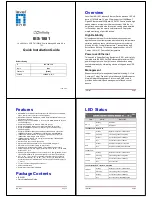
Raisecom
ISCOM2600G-HI (A) Series Configuration Guide
10 Security
Raisecom Proprietary and Confidential
Copyright © Raisecom Technology Co., Ltd.
426
Raisecom#user login tacacs-user
Raisecom#enable login local-tacacs
Checking results
Use the
show tacacs-server
command to show configurations.
Raisecom#show tacacs-server
Server Address : 192.168.1.1
Port: --
Backup Server Address : --
Port: --
Server Shared Key : oLMCKszV2X38
Backup Authentication server Shared Key: --
Accounting server Address : --
port: --
Backup Accounting server Address: --
Port: --
Accounting server Shared Key: --
Backup Accounting server Shared Key: --
Total Packet Sent : 0
Total Packet Recv : 0
Num of Error Packets : 0
10.6 Storm control
10.6.1 Introduction
The Layer 2 network is a broadcast domain. When an interface receives excessive broadcast,
unknown multicast, and unknown unicast packets, broadcast storm occurs. If you do not
control broadcast packets, broadcast storm may occur and occupy much network bandwidth.
Broadcast storm can degrade network performance and impact forwarding of unicast packets
or even lead to communication halt.
Restricting broadcast flow generated from network on Layer 2 device can suppress broadcast
storm and ensure common unicast forwarding normally.
Occurrence of broadcast storm
The following flows may cause broadcast flow:
Unknown unicast packets: unicast packets of which the destination MAC is not in the
MAC address table, namely, the Destination Lookup Failure (DLF) packets. If these
packets are excessive in a period, the system floods them and broadcast storm may occur.
Unknown multicast packets: the ISCOM2600G-HI series switch neither supports
multicast nor has a multicast MAC address table, so it processes received multicast
packets as unknown multicast packets.
















































